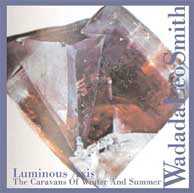
One of the many things John Zorn's Tzadik has done well is documenting the great trumpet player Wadada Leo Smith. Smith has released two dozen records as a leader, most of which are sadly out of print.
Over the course of his first four albums for Tzadik, Smith was represented as a composer, jazz group leader and remarkable player. Luminous Axis builds on that - and on the fact that Smith shouldn't be pigeonholed too readily - with a set of compositions for trumpet and electronics that explore quite beautifully a new realm of the percussion-and-horn tradition.
The album is presented as a suite, with the subtitle "Caravans of Winter and Summer - An electronic Sonic Garden of Delights and Transformations Events 1-15." And while the players change over the course of the disc (five different groupings of seven musicians, the leader included, are employed), the "events" flow together well.
In feel, the album is closest to his excellent Kulture Jazz (ECM), a gorgeous record of solo trumpet and voice (both by Smith). But here, the Rastafari chants are replaced by a variety of electronic scrims supplied by Tim Perkis, Chris Brown, Mark Trayle, John Bischoff and Ikue Mori. Smith's playing is slow, relaxed, emotive, and the sounds below evocative and ever-shifting. Like Kulture Jazz, the album is quiet throughout, but never becomes a plateau of ambience.
Compellingly added to eight of the tracks is the great percussionist William Winant, a classically trained musician who has worked with Sonic Youth and a number of Zorn-led project. His set (timpani, bass drums, gongs, cymbals and bells) never overpowers the electronic percussionists. Winant does a remarkable job at staying within the computer-driven environment.
The album builds and dissolves, Winant disappearing after the first half, the groupings shrinking in size until Mori makes her appearance for the final 24 minutes. With such an impressive assemblage of players, it's bold to say that Mori raises the bar on an already striking record. On the other hand, it's not hard to assume that Smith put the three duets with her at the end for a reason. As always, Mori injects lovely atmospherics, enveloping Smith's crystalline trumpet in a perfectly paced coda.
The varied uses of electronics throughout (Smith applies effects to his horn as well) show again, and in another way, that Smith's subtlety as a composer shouldn't be mistaken for simplicity. There's as much structure in these pieces as the attention you want to apply.
Comments and Feedback:



More Recent Reviews, Articles, and Interviews @ The Squid's Ear...


|

